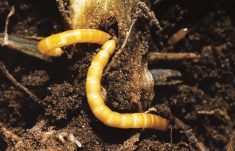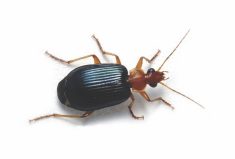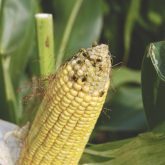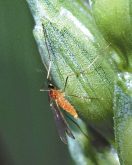Last year’s heat and drought didn’t do much for crops, but it certainly seemed to agree with grasshoppers and flea beetles. Does last season’s invasion mean there will be another for 2021?
Jennifer Otani, a pest management scientist with Agriculture and Agri-Food Canada in the Peace River region, says there were reports of high numbers of adult flea beetles aggregating on the pods or collecting on machinery during last year’s harvest in some areas of the Prairies.
Otani says that although the presence of newly emerging adults in late summer is normal, “we know that when it’s easy to find late-season flea beetles, we should anticipate a higher level of risk for the following spring. It does elevate the prioritization of spring scouting.”
Read Also

Sensing the soil: Root cell research finds ‘stress hormone’
Research into how root cells react to soil stressors could help plants better adapt to changes in their climate.
She says several factors influence overwintering survival, including adult movement, reproductive capacity and survival of larvae to pupae in the soil, along with emergence and dispersal of the newly emerging adults. If flea beetle densities are indeed high early in the spring, it may be critical to scout daily, especially if seedlings aren’t growing quickly.

Zero-till advantage
Rotation reduces some flea beetle risk. “In some years, we’ve seen producers end up with canola-on-canola rotations and the concern here is that flea beetles and other insect pests of canola really have a continuous buffet,” Otani says.
James Tansey, provincial pest management specialist for the Saskatchewan Ministry of Agriculture, says there’s some evidence that zero till can help with flea beetle control, as they prefer open habitat. This may be due to better accumulation of heat and/or the effect of debris impeding their movement.
Manitoba Agriculture entomologist John Gavloski says the insects prefer environments that are exposed to bright sunlight and are relatively warm. “Direct seeding into standing stubble provides a microclimate which is less ideal for flea beetles. This seeding method often produces larger plants early and may reduce the producer’s dependence on insecticides, except under conditions of intense flea beetle pressure.”
Theoretically, cover crops with their extra debris could also impede the movement of flea beetles. Last summer, there were reports that a Manitoba field of canola seeded into a terminated rye cover crop was hardly touched by the insects.
Otani says more work needs to be done to address which crops might work, what rotations might prove beneficial in overall flea beetle management, with regional differences to be expected.
Tansey says there’s some evidence that higher seeding rates can provide some flea beetle control. Treated seed is expensive, but he notes that seed treatment in addition to in-season overspray was often required in 2021 and may be needed again in 2022, especially if it’s another warm, dry year.
“We certainly saw a need for spraying last year and in some cases, multiple spray treatments were needed, but hold to the economic thresholds. If you’re seeing 25 per cent defoliation in canola, that’s the threshold and act quickly.
“But if your canola is past the four-leaf stage, the plants can tolerate a lot of defoliation, and spraying for flea beetles may not be useful. Keep an eye on the populations, though. If numbers are very high and great damage is accumulating, control may still be needed even at this stage.” Otani says that an early, dry spring could mean that seeding can be started early, but overwintering insects like flea beetles would also become active early.
“Spring growing conditions, and especially soil moisture levels, will factor heavily in the ability of canola seedling to pop up, grow and quickly get past that most vulnerable growth stage,” she says. “Once it’s seeded, growers really must scout. It’s always best to never assume anything when it comes to spring flea beetles.”
Know your hoppers
Gavloski says there are five main species of grasshoppers that are potential crop pests on the Prairies, and they all have different food preferences. Therefore, knowing the dominant species on your farm can determine which crops may be affected.
“For example, clearwinged grasshopper is primarily a grass feeder and seldom feeds on broad-leaved plants. Some crops, such as peas or oats, may be less preferred by some species … but grasshoppers will still feed on them.”

Much of the egg hatch for the potential pest species is usually in late May or early June. Gavloski says that earlier-seeded crops can sometimes tolerate grasshopper feeding better than late-seeded crops.
A Manitoba Agriculture factsheet says seed density can be increased along field margins. “For example, doubling the planting populations for a strip that is between 20 to 40 metres wide around the field edge. This increased plant stand should slow the movement of grasshoppers into the rest of the field, and compensate for lost seedlings.”
Spraying threshold
Tansey says the economic spray threshold for grasshoppers is 10-12 large nymphs or adults per square metre for most crops. Lentils and flax in boll are more sensitive so thresholds of two per square metre should be used.
“There’s no economic benefit before that and negative effects to the natural enemies of grasshoppers can occur, so hold to the threshold. Don’t use a calendar spraying schedule, but instead scout and take timely action if you hit the threshold.”
The Manitoba Agriculture factsheet says if timely rains keep the vegetation in and around hatching beds green, grasshoppers may not move to adjacent crops until later in the season. Early scouting should therefore focus on areas of anticipated egg hatch.
In addition, remember that when grasshoppers are young, they can be confused with some of the larger species of leafhoppers which can be abundant in the vegetation around fields but are not crop pests.
Tansey says if 2022 is another warm, dry year, both flea beetles and grasshoppers will do well, and if it’s hot, grasshoppers can thrive. “Striped flea beetle activity starts to diminish at about 26 Celsius and crucifer flea beetle is more heat-tolerant but its activity is low in the mid-30s,” he says.
“However, grasshoppers like it warm and the optimum temperatures for the activity for some of the pest grasshopper species is in the 30s. Effective scouting for both flea beetles and grasshoppers is your most powerful tool.”
More information:
- Updated Manitoba Agriculture grasshopper factsheet, including photos of the harmful species
- Manitoba Agriculture flea beetles factsheet
- The Prairie Pest Monitoring network has weekly updates in the growing season, with information such as monitoring protocols, risk maps and a wind watch.
- In-season insect maps for Alberta















